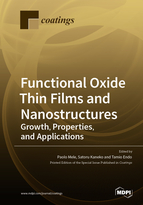Functional Oxide Thin Films and Nanostructures: Growth, Properties, and Applications
A special issue of Coatings (ISSN 2079-6412). This special issue belongs to the section "Thin Films".
Deadline for manuscript submissions: closed (31 May 2022) | Viewed by 25345
Special Issue Editors
Interests: thin films; oxides; superconductors; thermoelectrics; energy materials; heat transfer; vortex matter; sustainability
Special Issues, Collections and Topics in MDPI journals
Interests: oxide thin films; graphene; carbon composites
Special Issue Information
Dear Colleagues,
It is our pleasure and honor to invite you to submit your contribution to this Special Issue of Coatings entitled “Functional Oxide Thin Films and Nanostructures: Growth, Properties, and Applications”.
Recent materials nanotechnologies have brought possibilities of fabrication of oxide thin films in nanometric level, as well as of other nanocomposites. In parallel, recent measurement technologies can supply characterizations of their unique properties arising from limited regions of surfaces and interfaces. This Special Issue provides an opportunity to share surface-related science and engineering topics on oxide thin films and nanocomposites in an interactive and interdisciplinary manner. The ultimate goal is to elucidate commonalities and differences between multilayer interfaces and nanocomposite grain boundaries.
This Special Issue is intended as an effort to bridge the gap between materials science and the applications of oxide thin films and nanostructures.
In particular, the topics of interest include but are not limited to:
- Novel technologies to fabricate oxide nanomaterials;
- Flexible and mechanically rigid oxide materials;
- Wide categories of functional oxides (semiconducting, superconducting, magnetic, ferroelectric, multiferroic, optical);
- Understanding of structures and properties of oxide materials effectively exhibiting above functions;
- Similarities and differences between “normal thin films” and “ultrathin films and multilayers”, influenced by surfaces and interfaces;
- Similarities and differences between “normal composites” and “nanocomposites”, influenced by larger and smaller grain
Prof. Dr. Paolo Mele
Dr. Satoru Kaneko
Prof. emer. Tamio Endo
Guest Editors
Manuscript Submission Information
Manuscripts should be submitted online at www.mdpi.com by registering and logging in to this website. Once you are registered, click here to go to the submission form. Manuscripts can be submitted until the deadline. All submissions that pass pre-check are peer-reviewed. Accepted papers will be published continuously in the journal (as soon as accepted) and will be listed together on the special issue website. Research articles, review articles as well as short communications are invited. For planned papers, a title and short abstract (about 100 words) can be sent to the Editorial Office for announcement on this website.
Submitted manuscripts should not have been published previously, nor be under consideration for publication elsewhere (except conference proceedings papers). All manuscripts are thoroughly refereed through a single-blind peer-review process. A guide for authors and other relevant information for submission of manuscripts is available on the Instructions for Authors page. Coatings is an international peer-reviewed open access monthly journal published by MDPI.
Please visit the Instructions for Authors page before submitting a manuscript. The Article Processing Charge (APC) for publication in this open access journal is 2600 CHF (Swiss Francs). Submitted papers should be well formatted and use good English. Authors may use MDPI's English editing service prior to publication or during author revisions.
Keywords
- oxide materials
- thin films
- multilayers
- nanostructuration
- functional oxides
- structure/property correlations







